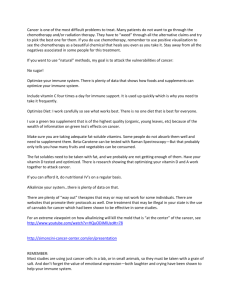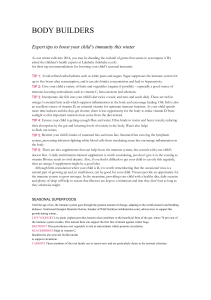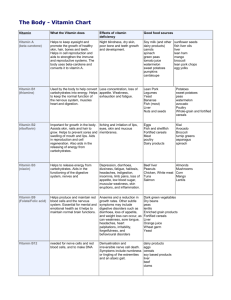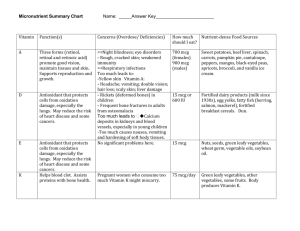functional food components
advertisement
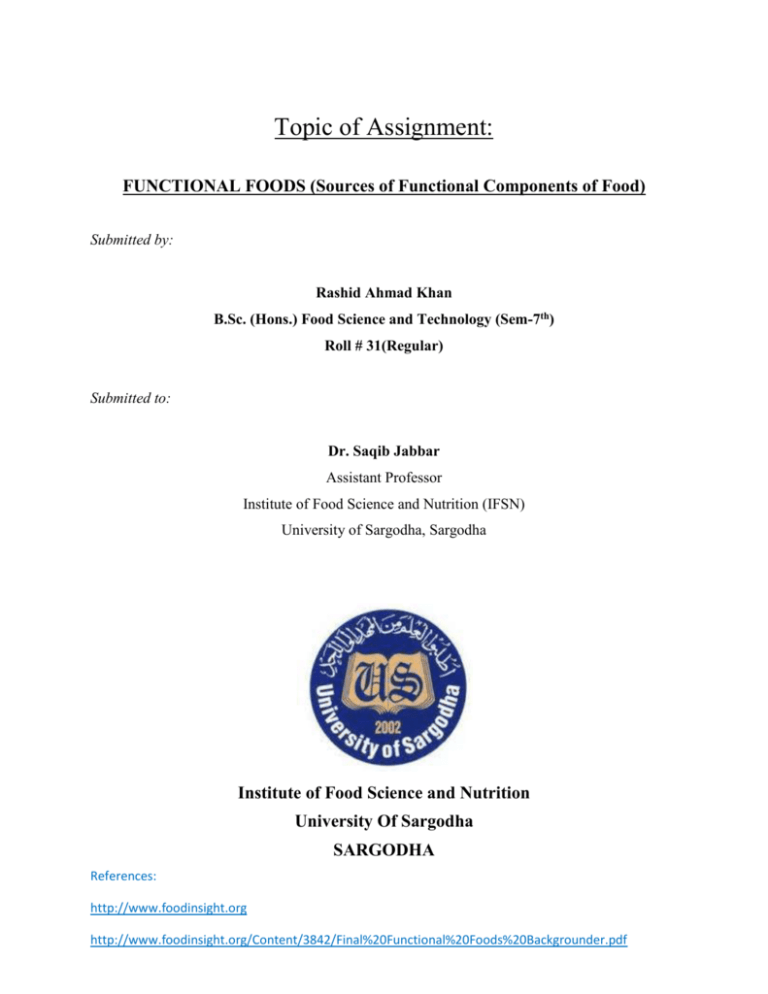
Topic of Assignment: FUNCTIONAL FOODS (Sources of Functional Components of Food) Submitted by: Rashid Ahmad Khan B.Sc. (Hons.) Food Science and Technology (Sem-7th) Roll # 31(Regular) Submitted to: Dr. Saqib Jabbar Assistant Professor Institute of Food Science and Nutrition (IFSN) University of Sargodha, Sargodha Institute of Food Science and Nutrition University Of Sargodha SARGODHA References: http://www.foodinsight.org http://www.foodinsight.org/Content/3842/Final%20Functional%20Foods%20Backgrounder.pdf FUNCTIONAL FOOD COMPONENTS (CAROTENOIDS) COMPONENT Beta-carotene SOURCE carrots, pumpkin, sweet potatoes, cantaloupe, spinach, tomatoes Lutein, Zeaxanthin kale, collards, spinach, corn, eggs, citrus fruits, asparagus, carrots, broccoli tomatoes and processed tomato products, watermelon, red/pink grapefruit Lycopene ROLE IN HUMAN BODY neutralizes free radicals which may damage cells; bolsters cellular antioxidant defenses; can be made into vitamin A in the body supports maintenance of eye health supports maintenance of prostate health FUNCTIONAL FOOD COMPONENTS (DIETARY FIBER) COMPONENT Insoluble fiber SOURCE wheat bran, corn bran, fruit skins Beta glucan oat bran, oatmeal, oat flour, barley, rye psyllium seed husk, peas, beans, apples, citrus fruits cereal grains, whole wheat bread, oatmeal, brown rice Soluble fiber Whole grains ROLE IN HUMAN BODY supports maintenance of digestive health; may reduce the risk of some types of cancer may reduce risk of coronary heart disease (CHD) may reduce risk of CHD and some types of cancer may reduce risk of CHD and some types of cancers; supports maintenance of healthy blood glucose levels FUNCTIONAL FOOD COMPONENTS (FATTY ACIDS) COMPONENT Monounsaturated fatty acids (MUFAs) Polyunsaturated fatty acids (PUFAs) – Omega-3 fatty acids— ALA PUFAs – Omega-3 fatty acids— DHA/EPA** SOURCE tree nuts, olive oil, canola oil ROLE IN HUMAN BODY may reduce risk of CHD walnuts, flaxseeds, flaxseed oil Conjugated linoleic acid (CLA) beef and lamb; some cheese supports maintenance of heart and eye health; supports maintenance of mental function oils may reduce risk of CHD; supports maintenance of eye health and mental function supports maintenance of desirable body composition and immune health salmon, tuna, marine and other fish References: http://www.foodinsight.org http://www.foodinsight.org/Content/3842/Final%20Functional%20Foods%20Backgrounder.pdf FUNCTIONAL FOOD COMPONENTS (FLAVONOIDS) COMPONENT Anthocyanins – Cyanidin, Pelargonidin, Delphinidin, Malvidin Flavanols – Catechins, Epicatechins, Epigallocatechin Procyanidins and Proanthocyanidins Flavanones – Hesperetin, Naringenin Flavonols – Quercetin, Kaempferol, Isorhamnetin, Myricetin SOURCE berries, cherries, red grapes tea, cocoa, chocolate, apples, grapes cranberries, cocoa, apples, strawberries, grapes, red wine, peanuts, cinnamon, tea, chocolate citrus fruits onions, apples, tea, broccoli ROLE IN HUMAN BODY bolster cellular antioxidant defenses; supports maintenance of healthy brain function supports maintenance of heart health supports maintenance of urinary tract health and heart health neutralizes free radicals which may damage cells; bolster cellular antioxidant defenses neutralizes free radicals which may damage cells; bolster cellular antioxidant defenses FUNCTIONAL FOOD COMPONENTS (MINERALS) COMPONENT Calcium Magnesium Potassium Selenium SOURCE sardines, spinach, yogurt, low-fat dairy products, fortified foods and beverages spinach, pumpkin seeds, whole grain breads and cereals, halibut, almonds, brazil nuts, beans potatoes, low-fat dairy products, whole grain breads and cereals, citrus juices, beans, banana, leafy greens fish, red meat, whole grains, garlic, liver, eggs ROLE IN HUMAN BODY may reduce the risk of osteoporosis supports maintenance of normal muscle and nerve function, immune health and bone health may reduce the risk of high blood pressure and stroke, in combination with a low sodium diet neutralizes free radicals which may damage cells; supports maintenance of immune and prostate health FUNCTIONAL FOOD COMPONENTS (PHENOLIC ACID) COMPONENT Caffeic acid, Ferulic acid SOURCE apples, pears, citrus fruits, some vegetables, whole grains, coffee ROLE IN HUMAN BODY bolsters cellular antioxidant defenses; supports maintenance of eye and heart health References: http://www.foodinsight.org http://www.foodinsight.org/Content/3842/Final%20Functional%20Foods%20Backgrounder.pdf FUNCTIONAL FOOD COMPONENTS (VITAMINS) COMPONENT Vitamin A SOURCE organ meats, milk, eggs, carrots, sweet potato, spinach Thiamin (Vitamin B1) lentils, peas, brown or enriched white rice, pistachios and certain fortified breakfast cereals lean meats, eggs, green leafy vegetables, dairy products and certain fortified breakfast cereals dairy products, poultry, fish, nuts, eggs and certain fortified breakfast cereals sweet potato, organ meats, lobster, soybeans, lentils and certain fortified breakfast cereals beans, nuts, legumes, fish, meat, whole grains and certain fortified breakfast cereals beans, legumes, citrus fruits, green leafy vegetables and fortified breads, cereals, pasta, rice eggs, meat, poultry, milk and certain fortified breakfast cereals Riboflavin (Vitamin B2) Niacin (Vitamin B3) Pantothenic acid (Vitamin B5) Pyridoxine (Vitamin B6) Folate or folic acid (Vitamin B9) B12 (Cobalamin) Biotin Vitamin C liver, salmon, dairy, eggs, oysters and certain fortified breakfast cereals guava, sweet red/green pepper, kiwi, citrus fruit, strawberries, fortified foods and beverages Vitamin D sunlight, fish, fortified foods such as yogurts or cereals, and beverages, including milk and juices Vitamin E sunflower seeds, almonds, hazelnuts, turnip greens, fortified foods and beverages ROLE IN HUMAN BODY supports maintenance of eye, immune and bone health; contributes to cell integrity supports maintenance of mental function; helps regulate metabolism supports cell growth; helps regulate metabolism supports cell growth; helps regulate metabolism helps regulate metabolism and hormone synthesis supports maintenance of immune health; helps regulate metabolism may reduce a woman’s risk of having a child with a brain or spinal cord defect; supports maintenance of immune health supports maintenance of mental function; helps regulate metabolism and supports blood cell formation helps regulate metabolism and hormone synthesis neutralizes free radicals which may damage cells; supports maintenance of bone and immune health may reduce the risk of osteoporosis; helps regulate calcium and phosphorus; supports immune health; helps support cell growth neutralizes free radicals, which may damage cells; supports maintenance of immune and heart health References: http://www.foodinsight.org http://www.foodinsight.org/Content/3842/Final%20Functional%20Foods%20Backgrounder.pdf FUNCTIONAL FOOD COMPONENTS (SULFIDES/THIOLS) COMPONENT Diallyl sulfide, Allyl methyl trisulfide SOURCE garlic, onions, leeks, scallions Dithiolthiones cruciferous vegetables ROLE IN HUMAN BODY may enhance detoxification of undesirable compounds; supports maintenance of heart, immune and digestive health may enhance detoxification of undesirable compounds; supports maintenance of healthy immune function FUNCTIONAL FOOD COMPONENTS (PROBIOTICS) COMPONENT Yeast, Lactobacilli, Bifidobacteria and other specific strains of beneficial bacteria SOURCE certain yogurts and other cultured dairy and nondairy applications ROLE IN HUMAN BODY supports maintenance of digestive and immune health; benefits are strain-specific FUNCTIONAL FOOD COMPONENTS (PREBIOTICS) COMPONENT Inulin, Fructo oligosaccharides (FOS), Poly-dextrose SOURCE whole grains, onions, some fruits, garlic, honey, leeks, banana, fortified foods and beverages ROLE IN HUMAN BODY supports maintenance of digestive health; supports calcium absorption References: http://www.foodinsight.org http://www.foodinsight.org/Content/3842/Final%20Functional%20Foods%20Backgrounder.pdf


